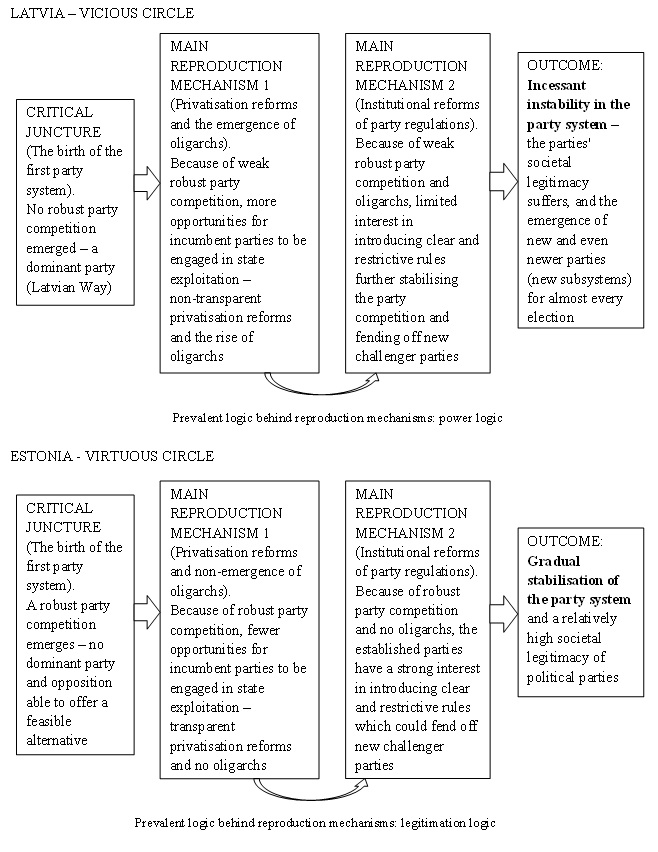DemPartBS
About DemPartBS
The post-doctoral research project, "The Quality of Democracy, Party System Institutionalization and Social Cleavages in the Baltic States (PUTJD1122) ", is funded by the Estonian Research Council. During the project, the primary principal investigator, Tõnis Saarts (Tallinn University), spent several months at the University of Nottingham (School of Politics and International Relations) as a post-doctoral fellow. He was supervised there by Associate Professor Fernando Casal Bértoa - one of the most preeminent scholars in Europe, studying the party systems and party system institutionalisation in old and new democracies.
The summary of the project: Democratic backsliding has recently become one of the major concerns for the new democracies in Central and Eastern Europe (CEE). So far, the process has not affected the Baltic States (BS). The puzzle has remained unsolved. Little attention has been paid to the specific features of the party systems in the BS. The project aims to understand: first, how the party systems (and the social cleavages underpinning them) have evolved and how the party systems have become institutionalised in the BS. Second, how the party system institutionalisation, in turn, has affected the quality of democracy while preventing (or facilitating) democratic backsliding? The first phase of the project will be focused on Estonia and Latvia, later, the BS (Lithuania included) will be compared with Poland and Hungary. The tentative results suggest that the Baltic party systems have acquired some peculiar features which make them more resilient to democratic backsliding than some other CEE countries.
The project's main deliverables were intended as two research articles: (1) focused on the evolution of the party systems in the Baltic States (more precisely in Estonia and Latvia), and (2) studying democratic backsliding in CEE where the Baltic States were compared with Poland and Hungary.
Article 1. The genesis of the party systems: the paths towards stability and instability in the Baltic States
The Estonian party system has gradually become one of the most consolidated and stable in CEE, while the Latvian one still situates on the very opposite pole while seeing the patterns of electoral volatility (Figure 1). The article seeks to explain the striking contrast between those otherwise similar countries. The study elaborates on the concept of "party system genesis" while employing the historical institutionalist framework and utilising its major notions as path-dependence, critical junctures and reproduction mechanisms.

Figure 1. Pedersen index of electoral volatility in Estonia and Latvia (and beyond).
Source: Casal Bértoa, 2022.
The major findings of the study demonstrated that the birth of the party system in the early 1990s in the Baltic States and the relevant patterns of party competition presented in it (robust or non-robust party competition) became a critical juncture which set in motion the path-dependent developments either leading to the gradual party system stabilisation (Estonia) or incessant instability (Latvia) (see Figure 2). The path dependency was further reinforced by two major reproduction mechanisms: (1) the privatisation reforms and the emergence (or non-emergence) of oligarchs, and (2) institutional reforms of party regulations. In the Latvian case, we see a vicious cycle in which the weak robust party competition in the first party system in the 1990s facilitated the rise of oligarchs and overly liberal rules in party regulations later – all this, in turn, further destabilised the party system. For Estonia, exactly the opposite pattern and a virtuous cycle became evident: robust party competition from the beginning, no oligarchs, and tight regulations on parties favouring the established parties. Furthermore, regarding the reproduction mechanisms, in Latvia, rather the power logic was prevalent: the incumbents or oligarchs sought to entrench their power position at the expense of their competitors. Whereas in Estonia (among the others), legitimation logic became more evident, in which the elites saw low corruption and well-ordered party politics as good things in their own right.

Figure 2. The genesis of the Latvian and Estonian party systems - virtuous and vicious circles.
Source: Author
The study seeks to contribute to the area studies that have been previously rather the Visegrad countries-centred. But first and foremost, there is a hope that the other scholars find the concept of "party system genesis" and the historical institutionalist framework employed in this paper useful and will apply it to the study of party systems in CEE and beyond.
The article was initially submitted to the journal Europe Asia Studies: the link will appear here when the article gets published.
Article 2. Why is there no democratic backsliding in the Baltic States?
Ethnic diversity is often seen as a serious impediment to successful democratisation and maintaining healthy democratic regimes (e.g. Rustow, 1970). However, regarding Central and Eastern Europe (CEE), one can see that democratic backsliding has rather affected monoethnic societies like Hungary and Poland, but not the Baltic States, with a sizable Russian minority. Why so? The article attempts to provide an answer to that "why" question. The main argument is that the Russian-speaking minority, the geopolitical threat posed by Russia and the excessive party system fragmentation or under-institutionalisation have saved the Baltic democracies from backsliding. The cross-cutting ethnic cleavage makes it very difficult for the populist radical right parties to form sizable and overarching class coalitions of discontent citizens. The precarious geopolitical position of the Baltic States makes it essential to maintain strong support from Western democracies and not experiment with illiberal forms of government. Finally, the excessive party system fragmentation and under-institutionalisation do not allow the populist parties to win legislative majorities to initiate more radical reforms. Hence, the research demonstrates that ethnic diversity foremost, but also geopolitical vulnerability and party system under-institutionalisation, could be rather a blessing, not a curse maintaining liberal democratic regimes.
The current geopolitical situation (the war in Ukraine) has suddenly increased the importance of the Baltic States as the bastion of liberal democracies in the European periphery and makes it more salient to understand the corresponding developments in the region. Nevertheless, the research goes beyond Eastern Europe and the Baltic States. It seeks to contribute to the wider academic discussion on democratic backsliding and democratisation while challenging some previous presumptions scholars have had about ethnic diversity, party system under-institutionalisation and geopolitical factors as impediments to successful democratisation.
The article was initially submitted to the Journal of Democracy: the link will appear here when the article gets published.
Project facts
- Partners: The University of Nottingham
- Duration: 01.02.2022−28.02.2023
- Total budget: 51 675 EUR (including overhead costs)
- Funding: The Estonian Research Council (PUTJD1122)
Project results:
- Saarts, Tõnis (2022). Party system closure: party alliances, government alternatives, and democracy in Europe. Journal of Baltic Studies, 54 (1), 150-152. DOI: 10.1080/01629778.2023.2162698.https://www.tandfonline.com/
doi/full/10.1080/01629778. 2023.2162698
Project Principal Investigator:

Associate Professor of Comparative Politics Tõnis Saarts, Tallinn University, Institute of Governance, Law and Society.
Narva mnt 29, 10120 Tallinn, Estonia



